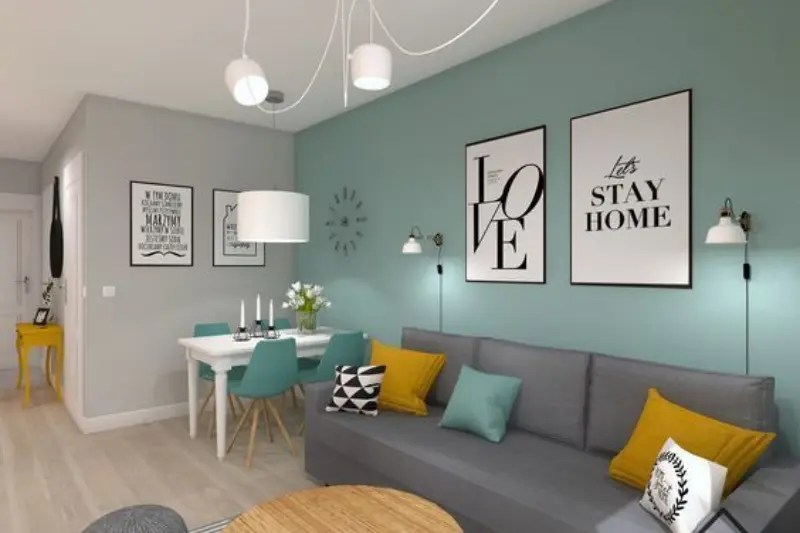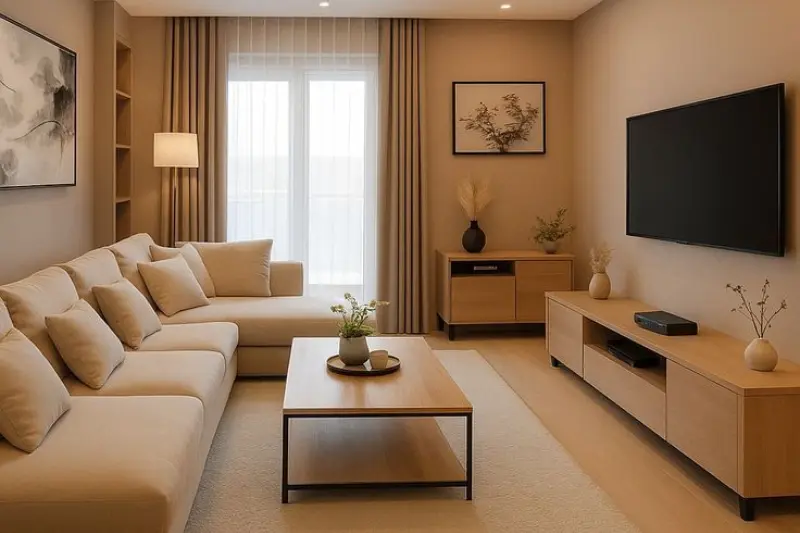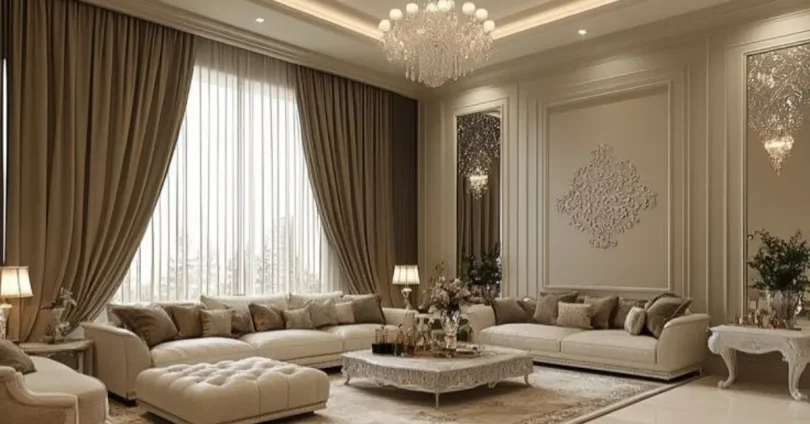Welcome to a world where style meets comfort! Interior design isn’t just about making your home look beautiful—Simple interior design ideas for homes also about creating a space that feels warm, functional, and truly yours. A well-designed home can lift your mood, improve daily living, and reflect your personality without needing a huge budget. The good news? You don’t need to be an expert or spend thousands to transform your home. With a few simple interior design ideas, you can make a big difference in how your space looks and feels.
Color and Light
Colors and lighting are the foundation of any beautiful home. They set the mood, create an illusion of space, and even affect how you feel in a room. Choosing the right shades and lighting tricks can make your home look stylish without requiring a full makeover.

1. Light and Neutral Wall Colors
Neutral tones like white, beige, cream, or soft gray are timeless choices for walls. They reflect more light, making small rooms appear larger and more open. These shades also give you flexibility—you can easily switch up your decor by adding colorful cushions, rugs, or wall art without needing to repaint the entire space. If you want a cozy vibe, try pastel tones like blush pink, mint green, or sky blue, which add personality without overwhelming the room.
2. Use Mirrors to Maximize Natural Light
Mirrors are one of the simplest and most effective interior design hacks. Placing a mirror opposite or beside a window reflects natural light around the room, instantly brightening up dark corners. A large wall mirror in the living room or a decorative mirror in the hallway can make your home feel more spacious and elegant.
3. Curtains and Blinds for Brightness
The type of window covering you choose can completely change how much light enters your home. Heavy, dark curtains often block sunlight and make rooms feel closed in. Instead, opt for sheer curtains or light-colored blinds. They allow natural light to flow in while maintaining privacy. For bedrooms, you can combine sheer curtains with blackout blinds to enjoy both brightness during the day and darkness when you need restful sleep.
4. Layered Lighting for the Evenings
While natural light is key during the day, artificial lighting sets the mood at night. Use a mix of ceiling lights, floor lamps, and table lamps to create a layered effect. Warm white bulbs work well for cozy areas like living rooms and bedrooms, while bright white lights are perfect for kitchens or study spaces. Dimmable lights are also a great option, letting you adjust brightness based on your mood or activity.
5. Highlight with Accent Colors
If you don’t want your room to look too plain, add pops of color through throw pillows, rugs, artwork, or vases. These accents stand out beautifully against neutral walls and give your home a stylish and lively look without much effort.
You may also like to read these posts:
Best Creative Writing Prompts for Beginners to Try Today
Easy Website Builders for Beginners Explained
Best Free Online Tools for Students and Professionals
Best Creative Writing Prompts for Beginners to Try Today
Declutter and Organize
A clutter-free home is not only more attractive but also makes daily life easier and stress-free. When your space is tidy and well-organized, it feels larger, cleaner, and more peaceful. The key is to keep only what you need and store everything else smartly.

1. Benefits of a Clutter-Free Home
Living in an organized space has many advantages. It reduces stress, saves time when looking for things, and creates a calm, welcoming atmosphere. A clutter-free home also makes it easier to decorate, as every piece of furniture and decor stands out instead of being lost in the mess.
2. Easy Storage Ideas
You don’t need fancy furniture to stay organized—just a few smart storage solutions:
- Baskets & Boxes – Perfect for keeping small items like toys, remote controls, or magazines out of sight.
- Open Shelves – Great for storing books, plants, or decorative items while adding style to your walls.
- Hidden Storage – Use storage ottomans, under-bed drawers, or coffee tables with compartments to keep things tucked away without taking up extra space.
3. Minimalist Design Tips
Minimalism doesn’t mean your home has to look empty—it’s about keeping only what’s useful and meaningful. Stick to clean lines, simple furniture, and a few statement pieces instead of filling rooms with too many items. A good rule is: if you haven’t used it in the past year, consider donating or removing it.
By decluttering and organizing, you not only make your home look neat but also create space for new design ideas that truly reflect your personality.
Furniture & Layout
The right furniture and smart arrangement can completely transform your home. Whether your space is small or spacious, choosing multifunctional pieces and arranging them thoughtfully makes a big difference in both comfort and style.
1. Smart Furniture Choices
Investing in furniture that serves more than one purpose is a smart way to save space and money. For example:
- Sofa Beds – Ideal for small apartments or guest rooms, as they provide seating by day and a bed by night.
- Foldable Dining Tables – Perfect for compact homes, allowing you to expand or shrink the table as needed.
- Storage Ottomans & Benches – They work as seating, footrests, or coffee tables while also hiding away extra items.
- Wall-Mounted Desks – Great for creating a home office corner without taking up too much space.
2. Arranging Furniture for Space and Flow
How you place your furniture affects how open and welcoming your home feels. Keep these tips in mind:
- Don’t block windows or doors, as they bring in light and air.
- Leave enough walking space between furniture for easy movement.
- Use rugs to define areas like the living or dining space in open layouts.
- Place larger items (like sofas or beds) against walls to maximize floor space.
3. Mixing Comfort with Style
While it’s important for furniture to look stylish, comfort should always come first. Choose sofas and chairs with soft cushions, beds with supportive mattresses, and dining chairs that are comfortable for long meals. To add style, play with textures, patterns, and colors—such as a cozy throw on the sofa or decorative cushions on the bed.
Smart furniture choices and thoughtful layouts not only make your home practical but also ensure it feels warm and inviting every day.
Add Life with Nature
Bringing nature indoors is one of the simplest ways to make your home feel fresh, vibrant, and welcoming. Plants not only improve the look of a room but also boost air quality and create a calming atmosphere.
1. Indoor Plants for Freshness and Health
Plants act as natural air purifiers, removing toxins and releasing oxygen into your home. They also reduce stress, improve mood, and bring a sense of peace. Adding greenery to your living room, bedroom, or even kitchen instantly makes the space feel alive and relaxing.
2. Low-Maintenance Plant Suggestions
Not everyone has time for plant care, but luckily many indoor plants are easy to maintain:
- Snake Plant (Sansevieria) – Needs very little water and survives in low light.
- Peace Lily – Adds elegance and thrives indoors with minimal care.
- Aloe Vera – Useful for skincare and grows well in sunny spots.
- Pothos (Money Plant) – Fast-growing and can be placed in water or soil.
- Succulents – Small, stylish, and perfect for desks or side tables.
These plants are great for beginners and require little effort to keep them thriving.
3. Using Planters as Decor Pieces
Planters are not just for holding plants—they can be part of your home’s style. Choose ceramic, wooden, or woven baskets for a natural touch, or go bold with colorful and patterned pots to add character. Hanging planters and wall-mounted plant holders are also great space-saving options for small homes.
By combining greenery with stylish planters, you can make your home feel cozy, healthy, and full of life.
Lighting Ideas
Lighting is more than just a practical need—it sets the mood, highlights your decor, and makes your home feel warm and inviting. A well-lit home looks bigger, cozier, and more stylish. By mixing different types of lights and choosing the right tones, you can completely transform any room.
1. Layered Lighting: Ceiling, Table Lamps, Floor Lamps
Instead of relying on just one light source, try layering your lighting for balance and depth.
- Ceiling Lights – Great for overall brightness in the room. Use simple designs like recessed lights or modern chandeliers to add elegance.
- Table Lamps – Perfect for bedside tables, desks, or side tables in the living room. They provide softer lighting for reading or relaxing.
- Floor Lamps – Ideal for corners or behind sofas, adding height and drama to your room’s design.
Layering ensures you always have the right level of brightness for every situation, from working to relaxing.
2. Warm vs. Cool Light for Different Moods
The color of light changes how a room feels:
- Warm Light (yellowish glow) – Creates a cozy, calm atmosphere, making it perfect for bedrooms and living rooms.
- Cool Light (white or bluish tone) – Energizing and bright, best for kitchens, bathrooms, or study areas where focus is important.
A mix of both can give you flexibility depending on the activity or time of day.
3. Affordable DIY Lighting Upgrades
You don’t need to spend a lot to improve your home’s lighting. Some simple, budget-friendly ideas include:
- Adding fairy lights to a bedroom or balcony for a magical feel.
- Using LED strip lights under shelves, cabinets, or behind the TV for a modern look.
- Replacing old bulbs with energy-efficient LED bulbs to save money and get better brightness.
- Repurposing jars, baskets, or bottles into creative DIY lampshades for a unique personal touch.
With a little creativity, lighting can become one of the most powerful design elements in your home.
Personal Touches & Decor
Your home should feel like yours—a space that reflects your personality, memories, and lifestyle. Adding personal touches and cozy decor elements can turn even the simplest home into a warm and inviting place.
1. Family Photos, Travel Souvenirs, or DIY Crafts
Decorating with meaningful items makes your home unique. Frame family photos and create a gallery wall, display souvenirs from your travels, or add handmade crafts for a personal vibe. These details not only beautify your space but also tell your story to anyone who visits.
2. Creating a Focal Point in Every Room
Every room should have one element that grabs attention and sets the tone. This could be:
- A bold piece of artwork on the wall.
- A colorful rug in the living room.
- A statement light fixture or chandelier.
- Even a decorated bookshelf or fireplace.
Focal points guide the eye and make the room feel thoughtfully designed without needing too many decorations.
3. Using Rugs, Cushions, and Textiles for Coziness
Soft furnishings are the easiest way to add comfort and charm to your home. Rugs define spaces, add warmth underfoot, and bring patterns or colors into a room. Cushions and throws on sofas or beds make your space look inviting while also providing comfort. Mix different textures like cotton, velvet, or wool to create depth and style.
By combining personal items with cozy decor pieces, you create a home that’s not only beautiful but also filled with warmth and memories.
Budget-Friendly Tips
You don’t need to spend a fortune to give your home a stylish makeover. With a little creativity and smart choices, you can transform your space while staying on budget. Here are some simple, cost-effective ideas:
1. Reusing Old Furniture with a Fresh Coat of Paint
Instead of throwing out old furniture, give it new life with paint or polish. A wooden chair can look brand new with a fresh coat of white paint, while an old dresser can be transformed with bold colors or even wallpaper on the drawers. This not only saves money but also gives your furniture a unique, custom look.
2. Shopping Smart: Thrift Stores & DIY Decor
Thrift shops, flea markets, and even online marketplaces often have hidden gems at low prices. From vintage mirrors to stylish lamps, you can find unique pieces that add character to your home. For an extra personal touch, try DIY decor like painting your own wall art, making candle holders from jars, or creating photo frames from recycled wood.
3. Small Changes That Create a Big Impact
Even little upgrades can completely refresh your home. Some easy ideas include:
- Changing cushion covers or adding new throws.
- Swapping old cabinet handles with modern ones.
- Adding a statement rug to define a space.
- Using removable wallpaper or wall stickers for a quick update.
- Rearranging furniture for a new layout without spending a single rupee.
These small, budget-friendly changes can instantly uplift your home’s style and make it feel brand new.
Common Mistakes to Avoid
Even with the best interior design ideas, small mistakes can make your home look cluttered or less welcoming. By avoiding these common errors, you can keep your space simple, stylish, and functional.
1. Overcrowding with Furniture
One of the most frequent design mistakes is filling a room with too much furniture. While it’s tempting to add extra chairs, tables, or shelves, this often makes the space feel cramped and hard to move around in. Instead, choose fewer but functional pieces that serve multiple purposes and leave enough room for easy movement.
2. Mixing Too Many Colors or Patterns
Colors and patterns add life to your home, but too many of them together can feel chaotic. For example, if you have bold wallpaper, avoid adding brightly patterned curtains or rugs in the same space. A good rule is to pick a base color (like white, beige, or gray), a secondary shade, and then add one or two accent colors for balance. This keeps your home looking stylish without being overwhelming.
3. Blocking Natural Light
Natural light makes rooms appear bigger, fresher, and more welcoming. Placing bulky furniture in front of windows or using heavy curtains can block sunlight and make the space feel dark. Always arrange furniture in a way that allows light to flow in freely, and use sheer curtains or blinds to maximize brightness.
By steering clear of these mistakes, you’ll ensure that your interior design feels both simple and effective, creating a home that’s open, comfortable, and inviting.
FAQs About Simple Interior Design Ideas for Homes
How can I make my small home look bigger with simple design ideas?
Use light wall colors, mirrors to reflect natural light, and minimal furniture to create an open and spacious feel.
What are the cheapest ways to decorate my home?
DIY decor, thrift store finds, fresh paint, and rearranging existing furniture are all budget-friendly ways to refresh your space.
Which indoor plants are best for home decoration?
Snake plants, peace lilies, pothos (money plant), aloe vera, and succulents are great low-maintenance options.
How do I choose the right lighting for my home?
Use layered lighting—ceiling lights for brightness, table lamps for focus, and floor lamps for ambiance. Warm lights create a cozy feel, while cool lights work best for workspaces.
How do I keep my home stylish but clutter-free?
Adopt a minimalist approach: keep only useful or meaningful items, use storage solutions like baskets and ottomans, and regularly declutter to maintain a clean look.
Conclusion
Creating a beautiful home doesn’t have to be complicated or expensive. With these simple interior design ideas for homes—like choosing light colors, maximizing natural light, decluttering, adding plants, and making smart furniture choices—you can completely refresh your space.
Remember, even small changes like swapping cushions, rearranging furniture, or adding a cozy rug can have a big impact. The key is to start simple and build on your style step by step.
Most importantly, let your home reflect you. Comfort and personal touches matter more than following strict design rules. When your home feels warm, inviting, and uniquely yours, that’s when interior design truly works its magic.







